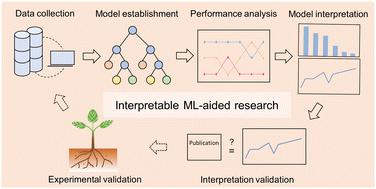当前位置:
X-MOL 学术
›
Environ. Sci.: Nano
›
论文详情
Our official English website, www.x-mol.net, welcomes your feedback! (Note: you will need to create a separate account there.)
Interpretable machine learning for investigating complex nanomaterial–plant–soil interactions
Environmental Science: Nano ( IF 7.3 ) Pub Date : 2022-10-04 , DOI: 10.1039/d2en00181k Hengjie Yu 1 , Zhilin Zhao 1 , Dan Luo 2 , Fang Cheng 1
Environmental Science: Nano ( IF 7.3 ) Pub Date : 2022-10-04 , DOI: 10.1039/d2en00181k Hengjie Yu 1 , Zhilin Zhao 1 , Dan Luo 2 , Fang Cheng 1
Affiliation

|
Soil serves as the main recipient of engineered nanomaterials (ENMs). Understanding the complex nanomaterial–plant–soil interactions is urgently needed to keep pace with the safety concerns of ENMs. Machine learning, suitable for learning complex patterns, has been used to predict the root uptake and translocation of ENMs. However, these models usually exist as black boxes, which are difficult to extract information and build trust. In this study, we first integrated the establishment, performance analysis, post hoc interpretation, and interpretation validation of light gradient boosting machine (LightGBM) model to investigate the root uptake of metal-oxide nanoparticles (MONPs) in the soil environment. The influence of the dataset split and data preprocessing on model performance was discussed as only limited data were available. Model predictions were explained by different post hoc interpretation methods to identify key factors and show how they affect the root uptake of MONPs and interact with the other factors. A three-step validation of the interpretation results was presented for assessing the reliability of the models and explanations. Further, a rule-based ensemble method with good interpretability, the RuleFit algorithm, was established to provide a model-based interpretation by generating rules and compared with post hoc interpretation methods. These post hoc and model-based interpretation methods can be integrated with experiments to promote the understanding of the risks and benefits of ENMs exposed to plants and help achieve a safety-by-design strategy of ENMs in numerous applications.
中文翻译:

用于研究复杂纳米材料-植物-土壤相互作用的可解释机器学习
土壤是工程纳米材料 (ENM) 的主要接受者。迫切需要了解复杂的纳米材料-植物-土壤相互作用,以跟上 ENM 的安全问题。适用于学习复杂模式的机器学习已被用于预测 ENM 的根吸收和易位。然而,这些模型通常以黑匣子的形式存在,难以提取信息和建立信任。在本研究中,我们首先整合了建立、性能分析、事后光梯度增强机 (LightGBM) 模型的解释和解释验证,以研究土壤环境中金属氧化物纳米粒子 (MONPs) 的根系吸收。由于只有有限的数据可用,因此讨论了数据集拆分和数据预处理对模型性能的影响。模型预测由不同的事后解释解释方法来识别关键因素并显示它们如何影响 MONPs 的根吸收并与其他因素相互作用。对解释结果进行了三步验证,以评估模型和解释的可靠性。此外,建立了具有良好可解释性的基于规则的集成方法RuleFit算法,通过生成规则并与事后解释方法进行比较来提供基于模型的解释。这些事后和基于模型的解释方法可以与实验相结合,以促进对暴露于植物的 ENM 的风险和益处的理解,并帮助在众多应用中实现 ENM 的安全设计策略。
更新日期:2022-10-04
中文翻译:

用于研究复杂纳米材料-植物-土壤相互作用的可解释机器学习
土壤是工程纳米材料 (ENM) 的主要接受者。迫切需要了解复杂的纳米材料-植物-土壤相互作用,以跟上 ENM 的安全问题。适用于学习复杂模式的机器学习已被用于预测 ENM 的根吸收和易位。然而,这些模型通常以黑匣子的形式存在,难以提取信息和建立信任。在本研究中,我们首先整合了建立、性能分析、事后光梯度增强机 (LightGBM) 模型的解释和解释验证,以研究土壤环境中金属氧化物纳米粒子 (MONPs) 的根系吸收。由于只有有限的数据可用,因此讨论了数据集拆分和数据预处理对模型性能的影响。模型预测由不同的事后解释解释方法来识别关键因素并显示它们如何影响 MONPs 的根吸收并与其他因素相互作用。对解释结果进行了三步验证,以评估模型和解释的可靠性。此外,建立了具有良好可解释性的基于规则的集成方法RuleFit算法,通过生成规则并与事后解释方法进行比较来提供基于模型的解释。这些事后和基于模型的解释方法可以与实验相结合,以促进对暴露于植物的 ENM 的风险和益处的理解,并帮助在众多应用中实现 ENM 的安全设计策略。



























 京公网安备 11010802027423号
京公网安备 11010802027423号